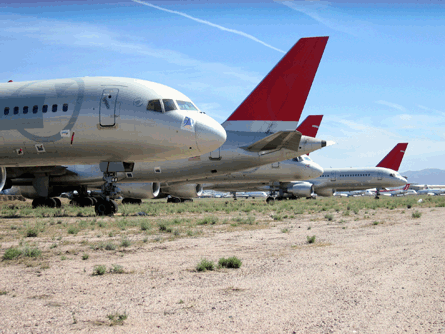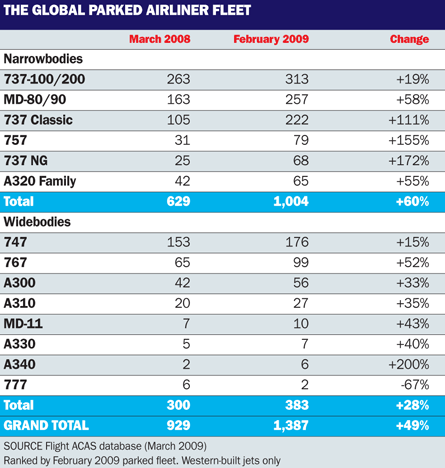As passenger demand slumps, airlines are under pressure to reduce capacity and park aircraft in an effort to avert further financial woes.
The International Air Transport Association has recently almost doubled its members' loss forecast in 2009 to $4.7 billion and expects a 12% drop in revenues for the industry to $467 billion. This, it points out, is far greater than the 7% dip experienced in the post-September 2001 crisis.
Director general Giovanni Bisignani describes the state of the industry as "grim", and expects passenger traffic will fall by 5.7%. Like the post-9/11 situation, the industry's order backlog is at an unprecedented high. In the meantime, older aircraft that are expensive to operate and which airlines can afford to fly when times are good, are being grounded in droves as running costs increase.
Because of overcapacity, the numbers of aircraft parked and available for sale or lease is increasing and values are declining. More old-generation aircraft will be permanently removed from service.
Chapter 2 aircraft, mainly narrowbody models such as Boeing 727-200s, 737-200s and McDonnell Douglas DC-9s, were the casualties of the last downturn. This time it is 737 Classics and MD-80s that are threatened.
 |
|---|
According to Flight's ACAS database, around 1,400 aircraft were parked at the end of February - 49% more than 12 months earlier. The bulk of these - over 70% - are narrowbodies.
Evergreen's facility at Marana, Arizona has recorded a number of increases in requests for parking aircraft over the past year as some aircraft have become uneconomical to operate in a high oil price environment.
Evergreen president John Keating says that there are 185 aircraft stored at the site. "We are starting to build the inventory again," he says. According to him, there were 160 aircraft stored at mid-2008.
Over the past six months, more Boeing 747-300/400s have arrived, along with 767s, while on the narrowbody side MD-80s and 737 Classics have been the main additions.
Keating predicts the peak will be in the summer. "Most of the stored fleet here is ex-US domestic carrier aircraft, although we have a few from Spain and China. Our forecast indicates we could have as many as 215 aircraft by the end of the summer."
 |
|---|
Appraisers predict more storage throughout the course of 2009, but many will at some stage be absorbed back into the market. Doug Kelly, Avitas vice-president asset aviation, expects the idle fleet to grow by 400 aircraft in the near term "because airlines will need to reduce capacity to meet lower demand. These will be the Chapter 2 aircraft, older 737 Classics, MD-80s and small regional jets. The number of parked aircraft would be much larger if fuel prices had remained high."
Keating is optimistic that economic conditions will improve within a year and that a fair proportion of the stored aircraft will be returned to service. He estimates that 40% of the current fleet could go back into the system. He is hopeful that demand for air travel will pick up again next year, and says: "I think our inventory will drop to around 180 aircraft by mid-2010."
While he predicts that the 737 Classics and the MD-80s will probably stay at the facility for another year, he is more optimistic about the widebodies. Keating says the old 747s, "run-out" (in need of major overhaul) DC-8s, DC-9s and DC-10s will not come back but the other widebodies could stay for "four to six months".
Evergreen's Marana facility has a 1.85 million m2 (20 million ft2) ramp and storage area that can hold up to 300 aircraft. "The advantage of this facility is that we can both store aircraft and offer maintenance through letter-checks," says Keating.
He adds: "Our range of services allows a client to temporarily park aircraft and perform maintenance that supports their aircraft's return to revenue service."
Evergreen's customer base includes airline customers from across the world that have parked diverse fleets ranging from DC-9s and 737s to 747s and more recently Boeing 757s. However, the bulk of the stored aircraft are owned by lessors, banks and hedge funds.
Source: Flight International
















